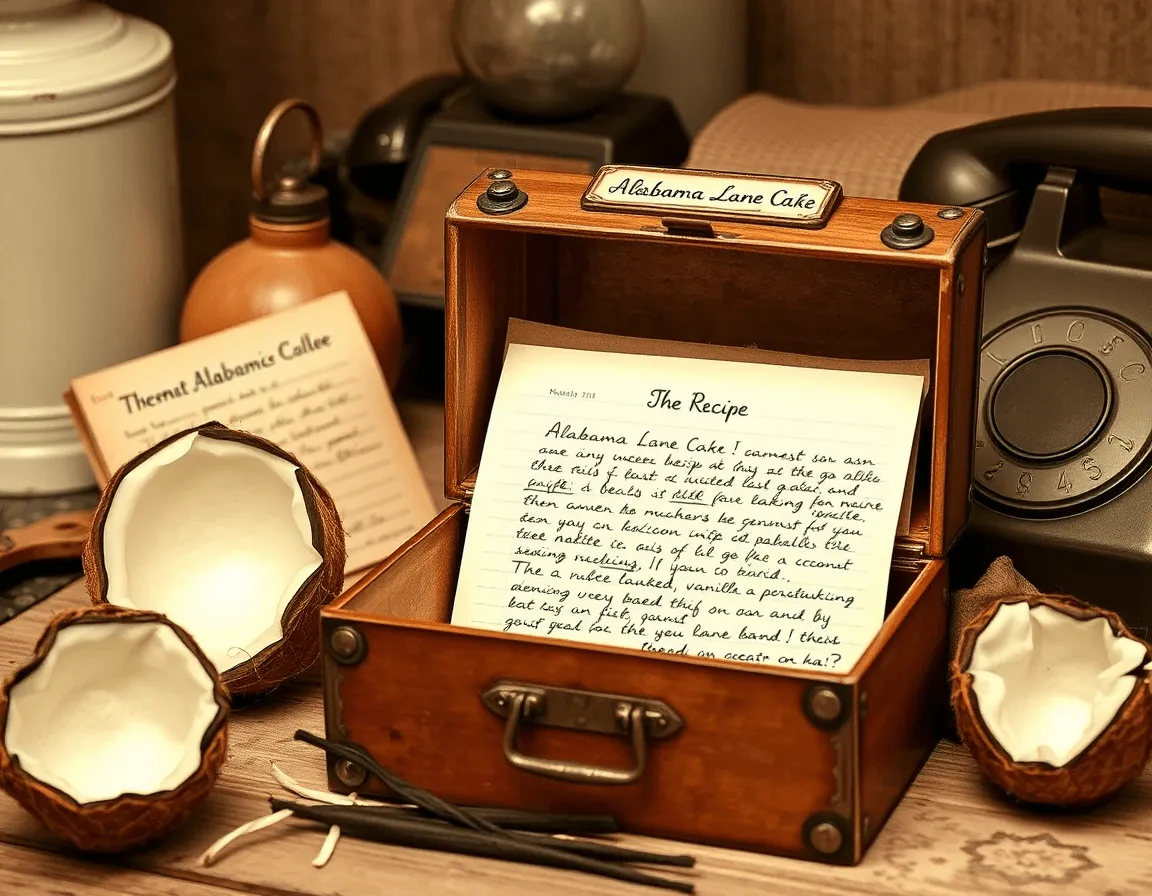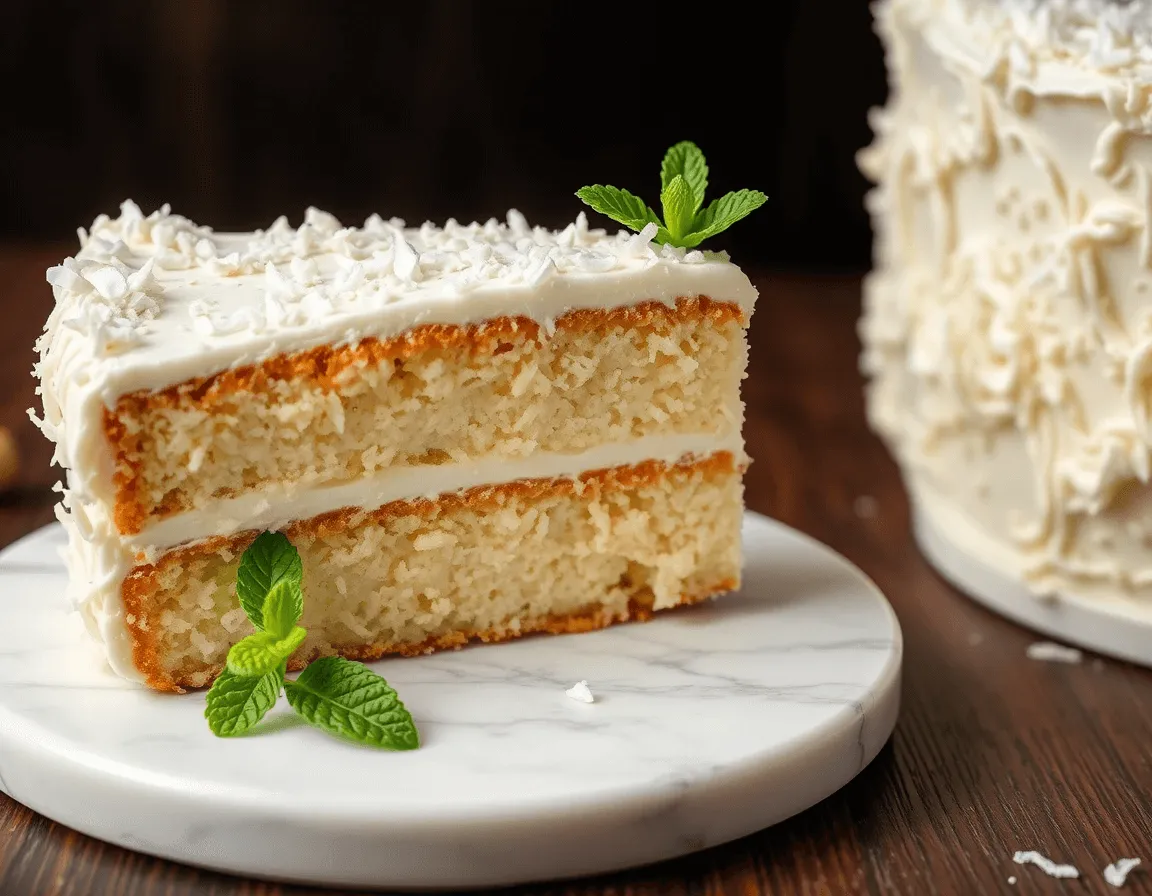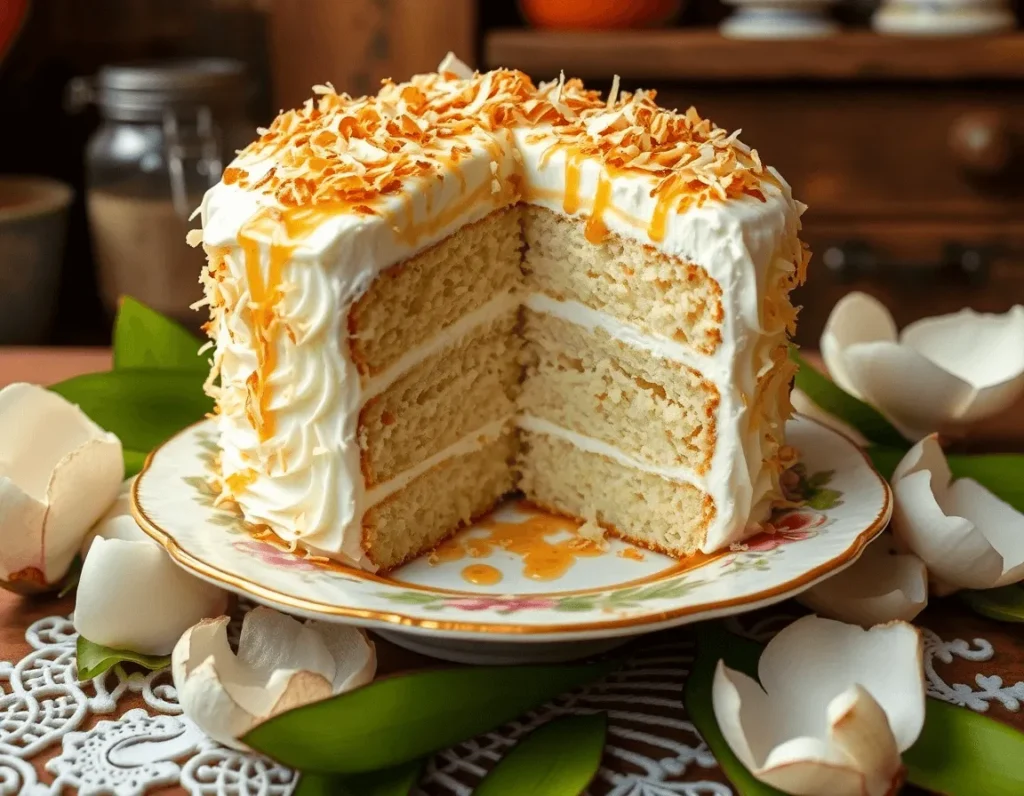A Slice of Southern Nostalgia
Let me paint you a picture: I’m six years old, standing on a wobbly stool beside my grandma’s counter, elbow-deep in a mixing bowl I could drown in. She slaps my hand away from the coconut shavings (“Not yet, baby — patience!”), but ten minutes later, she hands me the first slice of her Alabama Lane Cake Recipe . Layers so soft they squish when you press ’em, frosting that tastes like sweet cream and vanilla, and toasted coconut crunching like autumn leaves underfoot. That cake wasn’t just dessert. It was her yelling “Y’all better eat this before I do!” at Sunday dinner, or the way she’d sneak an extra sprinkle of coconut on top “for luck.”
Now I’m handing you her secrets — not the ones from a dusty cookbook, but the ones she whispered while stirring batter with one hand and shooing me away from the toaster oven with the other. No jargon, no “pro tips” — just how to nail those layers so moist, they’ll make your fridge jealous. Whether you’re baking for a crowd or hiding in the kitchen eating scraps straight off the pan (no shame — I’ve done both), let’s make your kitchen smell like hers: burnt butter, toasted coconut, and the faintest hint of vanilla that lingers like a hug long after the cake’s gone.
Table of Contents
The History & Cultural Roots of Alabama Lane Cake
Origins of a Southern Classic
Let’s get one thing straight: the Alabama Lane Cake Recipe didn’t just pop out of nowhere. It’s got roots—deep, messy, sugar-stained roots. Back in the 1800s, this cake was the Beyoncé of Southern desserts: everywhere, unforgettable, and slightly mysterious. Some say it’s named after a clever Alabama baker from the Lane family who whipped it up for a county fair. Others swear it’s just the South’s way of saying, “We love coconut, and we’re not sorry.” Either way, by the late 1800s, it was already hogging the spotlight in cookbooks, church bake sales, and yes—even fancy dinner parties where folks still called it “the Robert E. Lee cake” (though no one’s quite sure why).
A Cake That Meant Something
This wasn’t just sugar and flour—it was meaning . Julia Tyler, the First Lady with a Southern twang, allegedly devoured it at White House gatherings. Harper Lee even tucked it into To Kill a Mockingbird like a secret message about Southern comfort. And if you’ve ever been to the Alabama Shakespeare Festival, you know the real showstopper isn’t the actors—it’s the slice of Alabama Lane Cake Recipe they hand you at intermission.
What Makes It The Cake?
Here’s the deal: most coconut cakes are like loud cousins—sweet, but a little much. The Alabama Lane Cake Recipe ? It’s the cool aunt. Light layers that practically float off the plate, a buttermilk tang that keeps things real, and frosting so rich it’ll make your grandma raise an eyebrow. Oh, and the coconut? It’s not just sprinkled on top—it’s in the batter, the frosting, and toasted to golden perfection. Some folks even sneak in a splash of rum (coastal Alabama, anyone?) or crushed pecans for crunch.
Bottom Line:
It’s not just dessert. It’s history, hospitality, and a little bit of magic baked into every layer. Now, let’s get to the recipe—before I start waxing poetic about frosting again.

Ingredients & Tools You’ll Need
(Jump to the table below for a quick reference)
Why Quality Matters
Your ingredients determine the cake’s texture and flavor. Opt for full-fat buttermilk for tenderness and sweetened shredded coconut for the perfect balance of sweetness.
| Category | Details |
|---|---|
| Dry Ingredients | 3 cups cake flour, 1 tbsp baking powder, 1 tsp salt. |
| Wet Ingredients | 1 cup buttermilk, 4 large eggs, 2 tsp vanilla extract. |
| Coconut Elements | 1 ½ cups sweetened shredded coconut (divided for layers and frosting). |
| Tools | Stand mixer, three 9-inch round pans, cooling rack, pastry brush. |
Pro Tip : Toast ½ cup of coconut for the frosting to add a nutty crunch.
Ingredient Science :
- Cake Flour : Lower protein content ensures a delicate crumb.
- Buttermilk : Acidic pH reacts with baking powder for lift.
- Coconut Milk Syrup : Infuses moisture and binds layers.
Substitutions & Alternatives :
- Gluten-Free : Use Cup4Cup or Bob’s Red Mill 1:1 Baking Flour.
- Dairy-Free : Substitute buttermilk with coconut milk yogurt.
- Low-Sugar : Replace ½ cup sugar with coconut sugar (adjust liquid as needed).
Step-by-Step: How to Make Alabama Lane Cake (Without Crying Over Burnt Layers)
1. Prep Work: Don’t Rush This Part (Seriously)
First things first — crank your oven to 350°F (175°C). But wait — don’t just slap the pans in there willy-nilly. Grab a paper towel, dab some butter on the bottom and sides of your pans, then sprinkle in a few tablespoons of flour. Shake it around until the pan’s fully coated, then flip it upside-down and give it a good whack to knock out the extra flour. (Pro tip: Line the bottom with parchment paper — it’s like giving your cake a non-stick hug.)
Why this matters:
- Parchment paper isn’t just extra — it’s your insurance policy against cakes that stick like gum to a shoe.
- Oven temp? Trust me, ovens lie. Stick an oven thermometer in there to make sure it’s actually 350°F. My grandma swore her oven was fine… until her cake turned into a brick.
2. Batter Time: Cream, Mix, Repeat (But Don’t Overdo It)
Let’s get mixing! Pop 1 ½ cups of butter (not fridge-cold, please—softened like room-temp avocado) into a bowl. Add 2 cups of sugar and grab your mixer—or a wooden spoon if you’re channeling Grandma’s grit. Whip it together until it’s pale yellow and fluffy, like clouds you could almost sink your face into. This’ll take about 5 minutes if you’re using a mixer, or 8–10 if you’re arm-powering it. (Pro tip: If your butter’s harder than a brick, don’t panic. Zap it in 10-second bursts in the microwave until it’s squishable but not melted. Trust me, your cake will thank you.)
Now crack in 4 eggs, one at a time. Pause! Before you dump them in, crack each egg into a separate cup first. Why? Because unless you want shell shards in your cake, this is non-negotiable. Once the eggs are in, stir in a teaspoon of vanilla.
Time for the dry stuff: Sift 3 cups cake flour, 1 tbsp baking powder, and 1 tsp salt into another bowl. Gradually add it to the batter in three batches, alternating with 1 cup buttermilk. Think of it like layering lasagna—dry, wet, dry, wet, finish with dry. Fold in 1 cup shredded coconut last, like confetti for your cake.
Quick Tips (Because We’ve All Ruined a Cake or Two):
- Don’t overmix! Once the flour hits the batter, stop. Overmixing = tough cake. Seriously.
- Butter too cold? You’ll hear it—your mixer will groan like it’s lifting weights. Fix it by warming the butter next time.
Troubleshooting (Because Life Happens):
- Dense cake? Likely culprit: expired baking powder or overmixing.
- Dry crumbs? Your oven’s a bully. Bake 5 minutes less next time.
3. Bake & Cool: Patience Pays Off (Mostly)
Divide the batter evenly between your pans — use a kitchen scale if you’re a precision nerd (no judgment). Bake for 25–30 minutes. How to tell when it’s done? Stick a toothpick in the center — if it comes out clean (or with one or two damp crumbs), you’re golden. If it’s dripping wet, keep baking.
Now the hard part: Cooling
Let the cakes cool in the pans for 10 minutes (set a timer — I won’t judge if you forget and panic-scream when they stick). Then carefully flip them onto a wire rack. While they’re still warm, brush them with coconut milk syrup (mix ½ cup coconut milk + ½ cup sugar, simmer until sugar melts, then cool slightly). This is the secret to layers so moist, they’ll make your grandma gasp.
Pro Tip:
- If your layers look like they’re browning too fast, tent them loosely with foil.
4. Frosting & Assembly: Make It Pretty (Even If You’re Not a Pro)
Beat 1 cup butter with 4 cups powdered sugar, ½ cup coconut milk, and 1 tsp vanilla until smooth. Fold in ½ cup toasted coconut. Now, chill your cake layers in the fridge for 15–20 minutes — warm cakes + frosting = melty disaster.
How to assemble like a boss:
- Slather frosting between layers, then coat the outside. Use a bench scraper or offset spatula to smooth it out.
- Press toasted coconut onto the sides — or go wild with candied pecans for a Southern twist.
Frosting hacks:
- Too thick? Add a splash of coconut milk.
- Too thin? Pop it in the fridge for 10 minutes.
Final Touch (Because You Deserve a Standing Ovation):
Serve this Alabama Lane Cake Recipe with a dollop of pride and a side of sweet tea. It’s not just dessert — it’s a love letter to your taste buds (and anyone lucky enough to snag a slice).
The Secret to Moist Coconut Layers
Why Moisture Matters
The key to Alabama Lane Cake’s signature texture lies in hydration . Buttermilk keeps the crumb tender, while the coconut milk syrup locks in moisture.
Moisture-Boosting Techniques :
- Buttermilk : Acidic pH tenderizes gluten.
- Coconut Syrup Soak : Infuses layers with extra moisture.
- Frosting Seal : Traps moisture inside.
Avoid These Common Mistakes
- Overmixing the batter : Stir just until ingredients combine to prevent dense layers.
- Skipping the syrup : The coconut milk soak adds a subtle sweetness and keeps the cake fresh for days.
- Rushing the cooling process : Warm cakes will melt the frosting—wait until fully cooled.
Troubleshooting :
- Dry Cake? You likely overbaked it. Check doneness at 25 minutes.
- Dense Layers? Overmixing or expired baking powder could be the culprit.
Pro Tips & Variations
Customizations
- Add a twist : Stir ¼ cup dark rum into the frosting for a grown-up flavor.
- Gluten-free alternative: Use a 1:1 gluten-free blend in place of cake flour.
- Dairy-free : Use coconut milk yogurt instead of buttermilk.
Serving Suggestions
- Pair with sweet tea or bourbon-spiked coffee.
- Garnish with edible flowers for a modern touch.
Storage Tips
- Refrigerate : Keep for up to five days in an airtight container.
- Freeze : Wrap unfrosted layers in plastic and freeze for up to 3 months.
Travel-Friendly :
- Assemble layers separately and frost on-site to prevent smudging.

FAQ: Your Burning Questions, Answered (With a Side of Kitchen Wisdom)
1. What’s the secret to moist coconut layers?
Let me tell you a little secret my grandma whispered while we were elbow-deep in batter: it’s not just one thing — it’s three. First, buttermilk in the batter keeps the crumb tender. Second, brushing warm layers with coconut milk syrup (basically a 1:1 mix of coconut milk and sugar simmered until syrupy). Third? Wrap those layers tight while cooling — think “snug as a bug in a rug” so they don’t dry out.
2. Can I make this cake ahead?
Oh honey, yes! In fact, I beg you to do it. Bake the layers up to two days ahead, wrap ’em in plastic wrap, and stash ’em on your counter. Frosting? Make that day-of, unless you wanna fight a melty mess. Pro tip: If you’re really rushing, freeze the unfrosted layers for up to a month. Thaw ’em overnight, brush with syrup, and frost like a boss.
3. How do I toast coconut for the frosting?
Spread shredded coconut on a baking sheet (no oil needed — it’s got enough fat!) and pop it in a 350°F oven. Watch it like a hawk — it goes from pale to golden in 5–7 minutes. Set a timer! I’ve burned coconut twice (okay, five times) because I “thought I could multitask.”
4. Can I use fresh coconut instead of shredded?
Yep, fresh coconut works too! Just grate it fresh (or buy it that way if you’re not a masochist). Toast it before folding into the frosting — fresh coconut’s juicier, so it’ll need a few extra minutes in the oven to crisp up.
5. What if I don’t have buttermilk?
Okay, here’s the deal: I’ve been there. You’re mid-recipe, realize you’re out of buttermilk, and suddenly your cake feels doomed. Not today. Grab a measuring cup, crack open a tablespoon of lemon juice or vinegar (apple cider works fine), then fill the rest with regular milk. Let it sit while you preheat the oven — 5 minutes later, it’ll thicken and curdle just enough to mimic buttermilk. No fancy ingredients, no panic. Just science and survival.
6. How do I adjust for high altitude?
Living up in the mountains? Crank your oven temp up 15°F and shave ¼ tablespoon off the baking powder. High altitude = tricky layers. Trust me, I learned this the hard way after one cake puffed up like a soufflé and then collapsed into a sad coconut puddle.
7. Can I make cupcakes instead?
Oh, absolutely. Cupcakes are basically the Alabama Lane Cake’s chill little cousin who doesn’t stress about perfection. Fill those liners ⅔ full (no need to drown the paper) and bake at 350°F until a toothpick comes out clean — usually 18–20 minutes. And here’s the secret: cupcakes are way less drama than layers. Skip the coconut milk syrup unless you’re paranoid about dryness (I won’t judge — I’ve made both choices on different days). Frost ’em while cool, slap on some toasted coconut, and call it a win.
Final Touch:
Got more questions? Drop ’em in the comments — I’m here to rescue your cake dreams (or at least commiserate over burnt coconut). And hey, if you try this Alabama Lane Cake Recipe , snap a pic and tag me! I’ll feature your masterpiece (and maybe even steal your frosting technique).
Final Slice: Why This Cake Still Matters
Let’s be real — Alabama Lane Cake isn’t just layers of coconut and buttercream. It’s the smell of your grandma’s apron, the sound of her laugh when someone grabbed a second slice, and the way she’d say, “Honey, this recipe’s been through wars, weddings, and at least three hurricanes. Don’t mess it up.” When you bake this cake, you’re not just following steps — you’re holding a piece of her handwritten notes, the ones stained with vanilla and gossip.
So, bake it for your cousin’s birthday, for that neighbor who’s always “borrowing” your sugar, or just for yourself on a Tuesday because you deserve it . Watch how fast it disappears — faster than a mosquito at a Southern picnic. And if someone asks for the recipe? Just smile and say, “Darling, that’s a story for another time.”
Your Turn:
Snap a photo of your cake (or the empty plate — no judgment) and tag me. I’ll feature your masterpiece, and maybe even steal your frosting trick for next time. Because this isn’t just dessert — it’s how we keep the stories alive, one messy, glorious slice at a time.
Craving more Southern flavors? Explore our Desserts Collection for recipes that celebrate the best of Southern baking!


3 thoughts on “Alabama Lane Cake Recipe: The Ultimate Secret to Moist Coconut Layers”
Comments are closed.